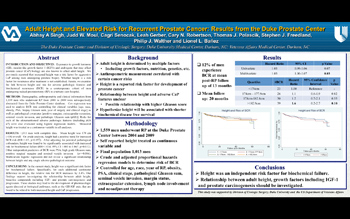WILLIAMSBURG, VA USA (UroToday.com) - Exposures to growth hormone (GH), insulin-like growth factor 1 (IGF1) and androgens that may affect prostate cancer (CaP) biology are also known to affect adult height.
We previously reported that increased height was a risk factor for aggressive CaP among men undergoing prostate biopsy. Whether height is a risk factor for recurrence after treatment is not established. Herein, we examine the link between height and risk for adverse pathologic features and biochemical recurrence (BCR) in a contemporary cohort of men undergoing radical prostatectomy (RP) in a tertiary-care hospital.
 Methods: Demographic, anthropometric and clinical information from 1 559 men who underwent RP from 2005 to 2009 were retrospectively abstracted from the Duke Prostate Center database. Cox regression was used to analyze BCR risk controlling for clinical variables (age, race, obesity, PSA, biopsy Gleason sum, year of surgery and clinical stage) as well as pathological covariates (positive margins, extracapsular extension, seminal vesicle invasion, and pathologic Gleason sum (pGS)). Risks for each of the aforementioned adverse pathologic features (including pGS ≥ 7) were also evaluated using logistic regression models. Measured height was treated as a continuous variable in all analyses.
Methods: Demographic, anthropometric and clinical information from 1 559 men who underwent RP from 2005 to 2009 were retrospectively abstracted from the Duke Prostate Center database. Cox regression was used to analyze BCR risk controlling for clinical variables (age, race, obesity, PSA, biopsy Gleason sum, year of surgery and clinical stage) as well as pathological covariates (positive margins, extracapsular extension, seminal vesicle invasion, and pathologic Gleason sum (pGS)). Risks for each of the aforementioned adverse pathologic features (including pGS ≥ 7) were also evaluated using logistic regression models. Measured height was treated as a continuous variable in all analyses.
Results: 1 013 men with complete data. Mean height was 178 cm (±18) overall. On crude analysis, height had a positive trend for increased BCR risk (HR=1.03, p=0.072). After adjusting for potential pathological cofounders, height was found to be significantly associated with increased risk for biochemical failure (HR=1.034, 95% CI 1.003 to 1.067, p=0.032). Other independent predictors of BCR were PSA, high-grade Gleason sum, positive surgical margins and seminal vesicle invasion (p ≤ 0.006). Multivariate logistic regression did not reveal a significant relationship between height and any single adverse pathological outcome.
Conclusions: In the current study, height was a significant risk factor for biochemical failure. Specifically, for each additional centimeter difference in height, the relative risk for BCR increases by 3.4%. Our findings support investigating the relationship between adult height, bioactive compounds including IGF1 and prostate carcinogenesis and progression. These studies may lead to the development of pharmacologic agents directed at biological pathways, such as the GH-IGF axis, that are found to be related to both increased height and CaP progression.
Presented by Abhay A. Singh, Judd W. Moul, Cagri Senocak, Leah Gerber, Cary N. Robertson, Thomas J. Polascik, Stephen J. Freedland, Philip J. Walther and Lionel L. Bañez at the 77th Annual Meeting of the Southeastern Section of the AUA - March 14 - 17, 2013 - Colonial Williamsburg Lodge - Williamsburg, VA USA
The Duke Prostate Center and Division of Urologic Surgery, Duke University Medical Center, Durham, NC USA; Veterans Affairs Medical Center, Durham, NC USA
View Full SES AUA 2013 Coverage



